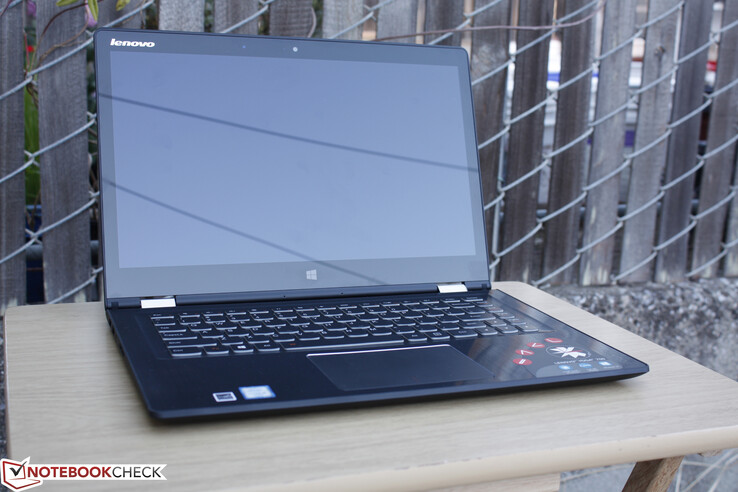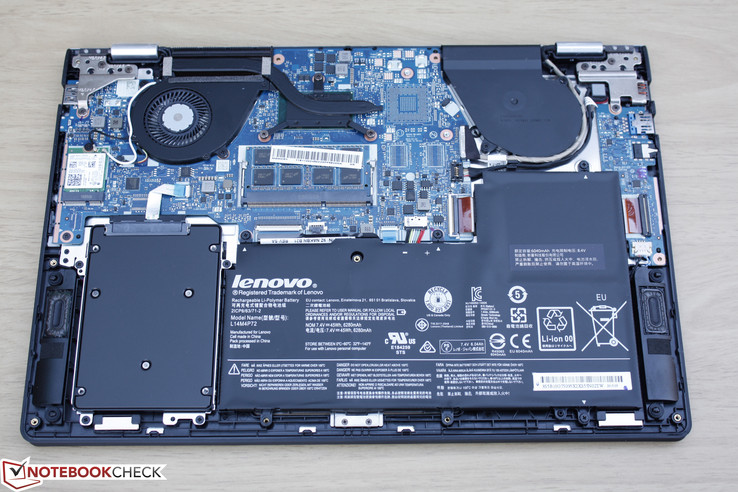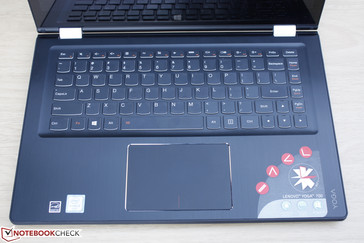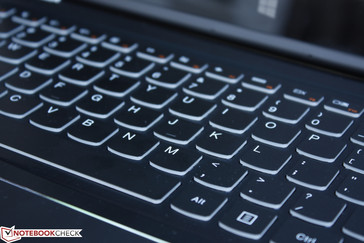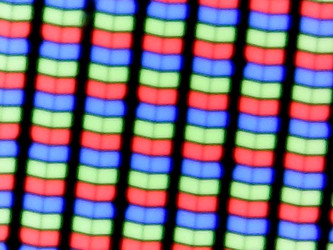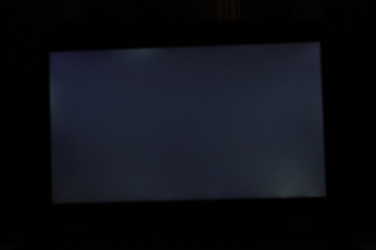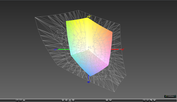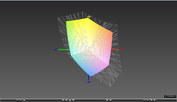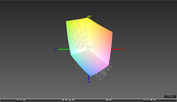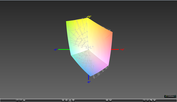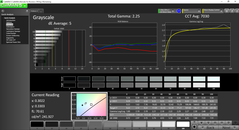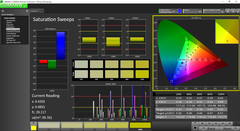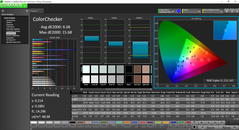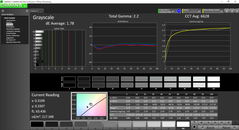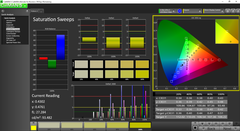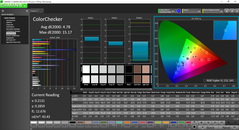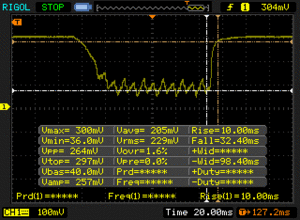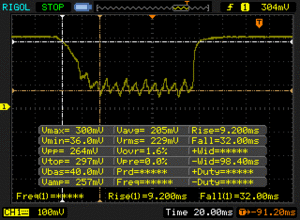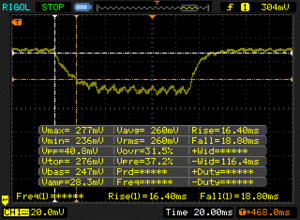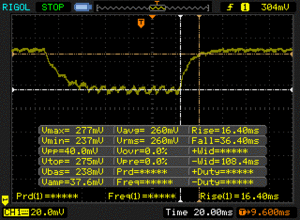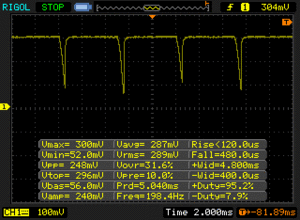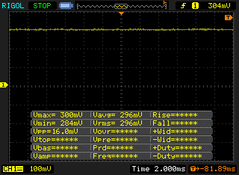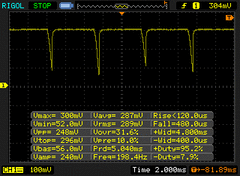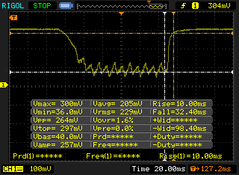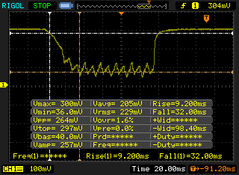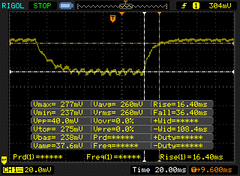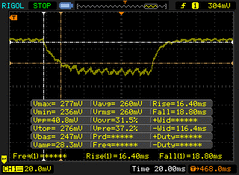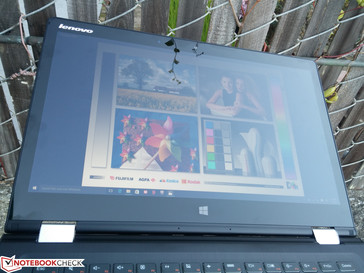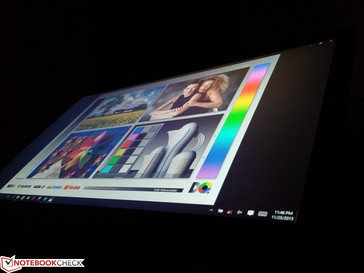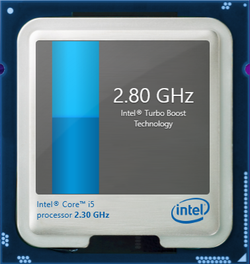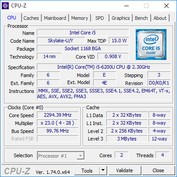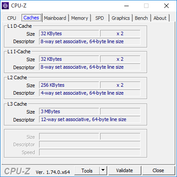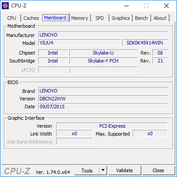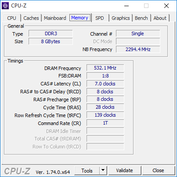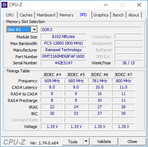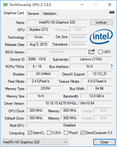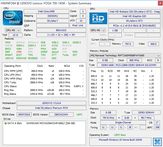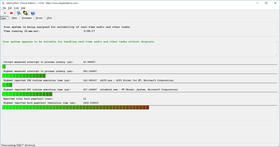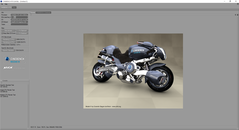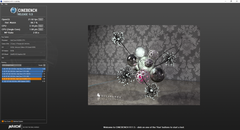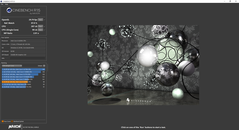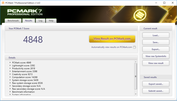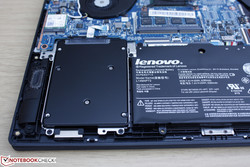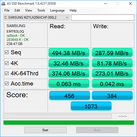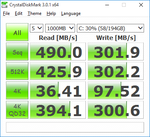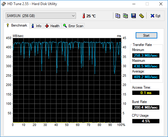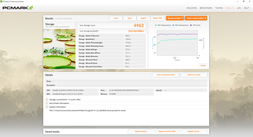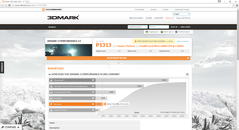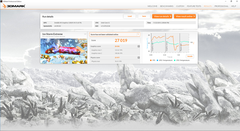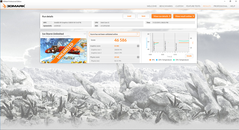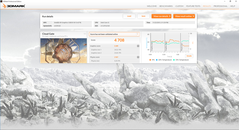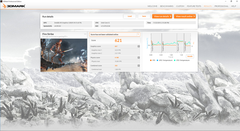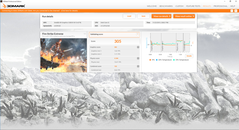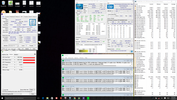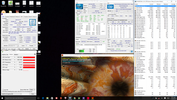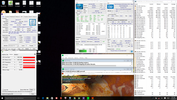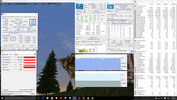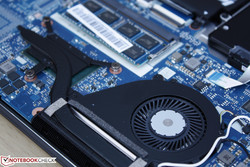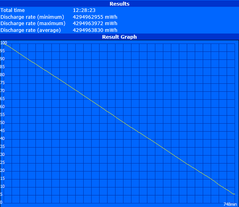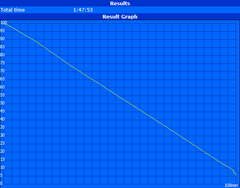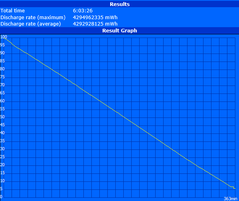Courte critique du Convertible Lenovo Yoga 700 14ISK

After just checking out the Yoga 900, we've now gone lower on the totem pole to the Yoga 700. This larger and more affordable version of the Yoga 900 brings the signature 360-degree hinges that the series is known for with Skylake for reduced power consumption and increased GPU performance. As an update to the 2014 Yoga 3 14, we recommend checking out our previous reviews for additional information on the series.
14-inch convertibles like the Yoga 700 are more uncommon compared to 13.3-inch convertibles. Nonetheless, the Yoga 700 competes against convertibles like the Acer Aspire R14 and Sony Vaio Flip 14A.
Top 10
» Le Top 10 des PC portables multimédia
» Le Top 10 des PC portables de jeu
» Le Top 10 des PC portables de jeu légers
» Le Top 10 des ordinateurs portables bureautiques
» Le Top 10 des PC portables bureautiques premium/professionnels
» Le Top 10 des Stations de travail mobiles
» Le Top 10 des Ultraportables
» Le Top 10 des Ultrabooks
» Le Top 10 des Convertibles
» Le Top 10 des Tablettes
» Le Top 10 des Tablettes Windows
» Le Top 10 des Smartphones
» Le Top 10 des PC Portables á moins de 300 euros
» Le Top 10 des PC Portables á moins de 500 euros
» Le Top 25 des meilleurs écrans d'ordinateurs
Case
We can quickly see right off the bat that the Yoga 700 is a rebrand of the Yoga 3 14 down to the design, plastic and brushed aluminum materials, and size. Thus, case quality is similar to last year's Yoga 3 14. This is both good and bad as we found last year's model to be well-made with a few flaws. First, pressing down on the center of the outer lid will cause both a slight depression and visible onscreen ripples. Secondly, the base and lid are not as rigid as a ThinkPad T model. For a consumer-level notebook, however, the Yoga 700 is built very well with no major or moderate quality issues.
When compared to the higher-end 13-inch Yoga 900, the 14-inch Yoga 700 is rounder and thicker and lacks the rubberized palm rests. The design is definitely less flashy and down-to-Earth since it lacks the Wristband hinge as well. Functionally, the hinges of the Yoga 700 are just as taut as on the Yoga 900, albeit with slightly more wobbling while sitting on a flat desk. The edges and corners retain the rubber bumpers for better support in Tent mode and better handling in Tablet mode.
At nearly 1.5 kg, the Yoga 700 is not the most comfortable device to use as a tablet while standing or moving. The HP Spectre x360 weighs about the same while the Yoga 900 is over 200 grams lighter. In this case, the smaller Yoga 900 is much easier to use in Tablet mode on every occasion.
Connectivity
Physical ports and port placement remain unchanged from the Yoga 3 14. The DC-in and USB 2.0 combo port is back alongside the Micro-HDMI port. The Yoga 900 replaces the Micro-HDMI port with the more versatile USB Type-C. We would have liked to see a full-size HDMI port or at least mini DisplayPort. Nonetheless, we appreciate the dedicated rotation-lock key instead of simply relying on software toggles.
Communication
Lenovo lists a "non-Intel" WiFi card in use for all of its Yoga 700 SKUs. After taking a closer look at the motherboard, our model is actually equipped with a removable Intel Wireless-AC 3165 1x1 M.2 module. This budget WLAN card offers theoretical transfer rates of up to 433 Mbps and integrates both Bluetooth 4.2 and WiDi functionality. We experienced no connectivity issues during our time with the test unit.
Additional wireless options such as WWAN or GPS are not supported on the Yoga 700.
Accessories
Included extras are light since this is a mainstream notebook. Optional accessories abound from Bluetooth mice and speakers to protective sleeves designed specifically for the Yoga 700 and Yoga 3 14.
Maintenance
Accessibility is relatively easy once the Torx screws are removed from the bottom panel. Upgrades are limited to the single SODIMM slot and 2.5-inch SATA bay.
Warranty
The standard one-year limited warranty applies. Lenovo provides one of the most extensive coverage options should buyers want additional protection.
Input Devices
Keyboard
The keyboard and touchpad have not changed from the Yoga 3 14. The size (27.75 x 10 cm) is sufficient and similar to the Yoga 900, but unfortunately with the same shallow travel and spongy feedback as on the Yoga 3 14. The keyboard tends to flex towards the center and it just cannot compete with the keyboards on flagship ThinkPad models. It's far from bad, but we hope that Lenovo can at least improve upon the travel for future iterations.
The keyboard backlight returns with just one level of brightness compared to two on the Yoga 900. Along with the keys and touchpad, everything is automatically disabled as soon as the notebook is opened 190 degrees or beyond. However, the keys do not automatically depress (no Lift n' Lock feature) like on the Lenovo ThinkPad Yoga models.
Touchpad
The 10.5 x 7 cm surface is slightly larger than the one on the Yoga 900 with the same integrated mouse keys. Instead of Synaptics, however, the Yoga 700 uses the Elan software and the plastic touchpad surface is lacking the slightly rubberized layer as found on the costlier Yoga 900. Scrolling and simple movements are smooth and bug-free. Pinch-to-zoom is on the slow side and works much more smoothly if using the multi-touch touchscreen for such functions instead.
The integrated mouse keys are shallow in travel with a soft auditory click and slightly spongy feedback. For example, it's possible to depress the touchpad without actuating the button to register the input. The force required to enter a click is more than on the Yoga 900 and higher than average, so it's a bit more strain on the hands and fingers.
Display
The glossy 14-inch capacitive touchscreen is fixed at 1920 x 1080 with no higher or lower configuration options. Unlike the Yoga 900, the subpixel structure on the Yoga 700 lacks a dedicated White pixel and is instead a standard RGB matrix. A quick search for the Chi Mei CMN14B6 display name shows no other notebooks sporting the same panel.
Display brightness has not improved over the Yoga 3 14. At an average of 210 nits, most Ultrabooks are brighter than the Lenovo. The notebook makes up for this with its good contrast of nearly 1000:1, which is a step better than its predecessor.
Subjectively, we can notice no general issues regarding display quality. Text and images are sharp and there is only very minor backlight bleeding on the bottom corner of the display. the screen is nowhere near as crisp as on the Yoga 900 as PPI is much lower on this mainstream Yoga (157 vs. 276).
| |||||||||||||||||||||||||
Homogénéité de la luminosité: 88 %
Valeur mesurée au centre, sur batterie: 224.5 cd/m²
Contraste: 980:1 (Valeurs des noirs: 0.229 cd/m²)
ΔE ColorChecker Calman: 6.06 | ∀{0.5-29.43 Ø4.78}
ΔE Greyscale Calman: 5 | ∀{0.09-98 Ø5}
61% sRGB (Argyll 1.6.3 3D)
39% AdobeRGB 1998 (Argyll 1.6.3 3D)
43.03% AdobeRGB 1998 (Argyll 3D)
61.8% sRGB (Argyll 3D)
41.58% Display P3 (Argyll 3D)
Gamma: 2.25
CCT: 7030 K
| Lenovo Yoga 700-14ISK 80QD 1920x1080 | HP Pavilion 14t-ab000 K9E07AV 1366x768 | Acer Aspire E5-473G-59QT 1920x1080 | Lenovo ThinkPad T450s-20BWS1UT00 1920x1080 | Lenovo Yoga 3 14 1920x1080 | Dell Latitude E7450 1920x1080 | |
|---|---|---|---|---|---|---|
| Display | -10% | -9% | 45% | 56% | ||
| Display P3 Coverage (%) | 41.58 | 37.38 -10% | 37.82 -9% | 64.8 56% | 66.6 60% | |
| sRGB Coverage (%) | 61.8 | 56.3 -9% | 56.9 -8% | 83.8 36% | 92.4 50% | |
| AdobeRGB 1998 Coverage (%) | 43.03 | 38.62 -10% | 39.07 -9% | 61.2 42% | 67.7 57% | |
| Response Times | ||||||
| Response Time Grey 50% / Grey 80% * (ms) | 52.8 ? | |||||
| Response Time Black / White * (ms) | 42 ? | |||||
| PWM Frequency (Hz) | 198 ? | |||||
| Screen | -77% | -45% | 18% | -8% | 20% | |
| Brightness middle (cd/m²) | 224.5 | 238.4 6% | 238 6% | 288 28% | 234.6 4% | 280 25% |
| Brightness (cd/m²) | 211 | 218 3% | 228 8% | 281 33% | 225 7% | 257 22% |
| Brightness Distribution (%) | 88 | 86 -2% | 90 2% | 94 7% | 82 -7% | 75 -15% |
| Black Level * (cd/m²) | 0.229 | 1.029 -349% | 0.54 -136% | 0.286 -25% | 0.394 -72% | 0.3 -31% |
| Contrast (:1) | 980 | 232 -76% | 441 -55% | 1007 3% | 595 -39% | 933 -5% |
| Colorchecker dE 2000 * | 6.06 | 12.21 -101% | 10.64 -76% | 4.35 28% | 5.22 14% | 3.45 43% |
| Greyscale dE 2000 * | 5 | 13.44 -169% | 11.74 -135% | 3.7 26% | 3.35 33% | 3.35 33% |
| Gamma | 2.25 98% | 2.11 104% | 2.42 91% | 2.68 82% | 2.27 97% | 2.37 93% |
| CCT | 7030 92% | 20097 32% | 13043 50% | 6076 107% | 6184 105% | 6940 94% |
| Color Space (Percent of AdobeRGB 1998) (%) | 39 | 38.62 -1% | 36 -8% | 54.7 40% | 36.92 -5% | 60 54% |
| Color Space (Percent of sRGB) (%) | 61 | 56.26 -8% | 57 -7% | 92 51% | ||
| Moyenne finale (programmes/paramètres) | -44% /
-61% | -27% /
-36% | 32% /
25% | -8% /
-8% | 38% /
29% |
* ... Moindre est la valeur, meilleures sont les performances
Color space coverage is typical for a mainstream notebook at just 36 percent and 61 percent of the AdobeRGB and sRGB standards, respectively. Costlier notebooks or certain business notebooks like the Dell Latitude E7450 or Lenovo ThinkPad T450s can portray deeper and more accurate colors than our Yoga 700.
Further measurements with an X-Rite spectrophotometer reveal an average grayscale and poor reproduction of Blue and Magenta colors. A calibration will improve grayscale and decrease color temperature, though color accuracy will not significantly improve. Colors become less accurate the higher the saturation level due to imperfect sRGB coverage.
Temps de réponse de l'écran
| ↔ Temps de réponse noir à blanc | ||
|---|---|---|
| 42 ms ... hausse ↗ et chute ↘ combinées | ↗ 10 ms hausse | |
| ↘ 32 ms chute | ||
| L'écran souffre de latences très élevées, à éviter pour le jeu. En comparaison, tous les appareils testés affichent entre 0.1 (minimum) et 240 (maximum) ms. » 98 % des appareils testés affichent de meilleures performances. Cela signifie que les latences relevées sont moins bonnes que la moyenne (20.2 ms) de tous les appareils testés. | ||
| ↔ Temps de réponse gris 50% à gris 80% | ||
| 52.8 ms ... hausse ↗ et chute ↘ combinées | ↗ 16.4 ms hausse | |
| ↘ 36.4 ms chute | ||
| L'écran souffre de latences très élevées, à éviter pour le jeu. En comparaison, tous les appareils testés affichent entre 0.165 (minimum) et 636 (maximum) ms. » 89 % des appareils testés affichent de meilleures performances. Cela signifie que les latences relevées sont moins bonnes que la moyenne (31.6 ms) de tous les appareils testés. | ||
Scintillement / MLI (Modulation de largeur d'impulsion)
| Scintillement / MLI (Modulation de largeur d'impulsion) décelé | 198 Hz | ≤ 90 Niveau de luminosité | |
Le rétroéclairage de l'écran scintille à la fréquence de 198 Hz (certainement du fait de l'utilisation d'une MDI - Modulation de largeur d'impulsion) à un niveau de luminosité inférieur ou égal à 90 % . Aucun scintillement ne devrait être perceptible au-dessus de cette valeur. La fréquence de rafraîchissement de 198 Hz est relativement faible, les personnes les plus sensibles devraient percevoir un scintillement et être sujettes à une fatigue oculaire accrue (avec le niveau de luminosité indiqué) En comparaison, 53 % des appareils testés n'emploient pas MDI pour assombrir leur écran. Nous avons relevé une moyenne à 8125 (minimum : 5 - maximum : 343500) Hz dans le cas où une MDI était active. | |||
Outdoor usability is average at best when under shade and uncomfortable when working under direct sunlight. It's clear that the backlight was purposefully designed to be dimmer than the costlier Yoga 900, so the Yoga 700 is best used indoors instead. Fortunately, maximum brightness will not drop if running on battery power.
Viewing angles are excellent due to the underlying IPS panel. This is expected since most - if not all - convertibles and detachables require wide viewing angles for multiple orientations.
Performance
Available SKUs include a Core i5-6200U up to a Core i7-6500U with the option for a discrete Nvidia GT 940M GPU. Our test model is the lower-end SKU with no dedicated graphics and only 8 GB of expandable RAM. The CPU will idle at just 500 MHz if on the Power Saver profile and can operate up to 2.7 to 2.8 GHz depending on the processing load. The dual-core ULV Skylake CPU is designed for home use and not necessarily for demanding applications where quad-core solutions can perform much faster.
LatencyMon reports no latency spikes on the Yoga 700 after an 8-minute test. This is surprising considering the amount pre-installed Lenovo software on our system.
Processor
Raw CPU performance from the Skylake core is between the Core i5-5200U and Core i5-6300U in multi-threaded operations. Performance is slightly slower than expected in single-threaded operations possibly due to weaker Turbo Boost performance out of the Yoga 700.
When compared to more power-hungry CPUs like the quad-core i7-4720HQ, the ULV i5-6200U is behind in single-threaded operations by around 20 percent. The performance delta grows significantly in multi-threaded operations where ULV cores can't compete against standard-voltage mobile CPUs.
More benchmarks and comparisons on the i5-6200U can be found on our dedicated CPU page here.
| Cinebench R15 | |
| CPU Single 64Bit (Classer selon les valeurs) | |
| Lenovo Yoga 700-14ISK 80QD | |
| Acer Aspire VN7-791G-79GT | |
| Microsoft Surface Book Core i5 | |
| HP EliteBook Folio 1040 G2 H7W22EA | |
| Acer TravelMate P257-M-56AX | |
| Toshiba Tecra Z40 A-147 | |
| CPU Multi 64Bit (Classer selon les valeurs) | |
| Lenovo Yoga 700-14ISK 80QD | |
| Acer Aspire VN7-791G-79GT | |
| Microsoft Surface Book Core i5 | |
| HP EliteBook Folio 1040 G2 H7W22EA | |
| Acer TravelMate P257-M-56AX | |
| Toshiba Tecra Z40 A-147 | |
| Cinebench R10 | |
| Rendering Single CPUs 64Bit (Classer selon les valeurs) | |
| Lenovo Yoga 700-14ISK 80QD | |
| Acer Aspire VN7-791G-79GT | |
| Microsoft Surface Book Core i5 | |
| HP EliteBook Folio 1040 G2 H7W22EA | |
| Toshiba Tecra Z40 A-147 | |
| Rendering Multiple CPUs 64Bit (Classer selon les valeurs) | |
| Lenovo Yoga 700-14ISK 80QD | |
| Acer Aspire VN7-791G-79GT | |
| Microsoft Surface Book Core i5 | |
| HP EliteBook Folio 1040 G2 H7W22EA | |
| Toshiba Tecra Z40 A-147 | |
| Cinebench R11.5 | |
| CPU Single 64Bit (Classer selon les valeurs) | |
| Lenovo Yoga 700-14ISK 80QD | |
| Acer Aspire VN7-791G-79GT | |
| Microsoft Surface Book Core i5 | |
| HP EliteBook Folio 1040 G2 H7W22EA | |
| Acer TravelMate P257-M-56AX | |
| Toshiba Tecra Z40 A-147 | |
| CPU Multi 64Bit (Classer selon les valeurs) | |
| Lenovo Yoga 700-14ISK 80QD | |
| Acer Aspire VN7-791G-79GT | |
| Microsoft Surface Book Core i5 | |
| HP EliteBook Folio 1040 G2 H7W22EA | |
| Acer TravelMate P257-M-56AX | |
| Toshiba Tecra Z40 A-147 | |
System Performance
PCMark scores are similar to other high-end models including the Surface Book and Dell XPS 13. Subjectively, we experienced no software or hardware related issues during out time with the notebook. The pre-installed McAfee tools may be bothersome if users have no intention of using the anti-virus software.
| PCMark 7 - Score (Classer selon les valeurs) | |
| Lenovo Yoga 700-14ISK 80QD | |
| Microsoft Surface Book Core i5 | |
| Dell XPS 13-9350 | |
| Lenovo ThinkPad T450s-20BWS03F00 | |
| Lenovo Yoga 3 14 | |
| PCMark 7 Score | 4848 points | |
| PCMark 8 Home Score Accelerated v2 | 3057 points | |
| PCMark 8 Creative Score Accelerated v2 | 3758 points | |
| PCMark 8 Work Score Accelerated v2 | 4289 points | |
Aide | ||
Storage Devices
The slim 2.5-inch SATA III bay is the sole storage option for the Yoga 700. The drive is thankfully easy to remove and replace as needed. Lenovo is currently offering the Yoga 700 with dedicated SSDs only for faster performance.
Our test model is equipped with the 256 GB Samsung MZYLN256HCHP SSD. Results from CrystalDiskMark show it to be a standard SATA III SSD with read speeds approaching 500 MB/s and write speeds at 300 MB/s. A fair amount of competing SSDs can offer faster sequential write speeds at over 400 MB/s including the Samsung SSD 840 EVO and Micron M600 M.2 drive.
See our growing list of HDDs and SSDs for more benchmarks and comparisons.
GPU Performance
Raw graphics performance from the HD 520 is roughly 20 percent ahead of the HD 4600 and 50 percent ahead of the even older HD 4000 according to 3DMark 11. Low-end Nvidia discrete graphics or the older Iris Pro Graphics 5200 will still outperform the HD 520 by even wider margins.
| 3DMark 11 | |
| 1280x720 Performance (Classer selon les valeurs) | |
| Lenovo Yoga 700-14ISK 80QD | |
| MSI GS30 Shadow | |
| Toshiba Satellite P50-C-10G | |
| Fujitsu LifeBook E554 | |
| Vizio CT14-A0 | |
| 1280x720 Performance GPU (Classer selon les valeurs) | |
| Lenovo Yoga 700-14ISK 80QD | |
| MSI GS30 Shadow | |
| Toshiba Satellite P50-C-10G | |
| Fujitsu LifeBook E554 | |
| Vizio CT14-A0 | |
| 3DMark | |
| 1920x1080 Fire Strike Score (Classer selon les valeurs) | |
| Lenovo Yoga 700-14ISK 80QD | |
| MSI GS30 Shadow | |
| Toshiba Satellite P50-C-10G | |
| Fujitsu LifeBook E554 | |
| Vizio CT14-A0 | |
| 1280x720 Cloud Gate Standard Score (Classer selon les valeurs) | |
| Lenovo Yoga 700-14ISK 80QD | |
| MSI GS30 Shadow | |
| Toshiba Satellite P50-C-10G | |
| Fujitsu LifeBook E554 | |
| Vizio CT14-A0 | |
| 1280x720 Ice Storm Standard Score (Classer selon les valeurs) | |
| Lenovo Yoga 700-14ISK 80QD | |
| MSI GS30 Shadow | |
| Toshiba Satellite P50-C-10G | |
| Fujitsu LifeBook E554 | |
| Vizio CT14-A0 | |
| 3DMark 11 Performance | 1313 points | |
| 3DMark Ice Storm Standard Score | 37935 points | |
| 3DMark Cloud Gate Standard Score | 4708 points | |
| 3DMark Fire Strike Score | 621 points | |
| 3DMark Fire Strike Extreme Score | 305 points | |
Aide | ||
Gaming Performance
The integrated HD Graphics 520 is still limited to Low to Medium settings on most titles even though it is upgrade from the HD 4600. Playing at the native resolution of 1080p is still out of reach, so we recommend upgrading to the vastly superior GT 940M if gaming is on the top of your list.
See our dedicated GPU page for more benchmarks and comparisons for the HD Graphics 520.
| Bas | Moyen | Élevé | Ultra | |
|---|---|---|---|---|
| Guild Wars 2 (2012) | 45.8 | 15.3 | 6.5 | |
| StarCraft II: Heart of the Swarm (2013) | 121.2 | 42.9 | 23.8 | 13 |
Stress Test
We stress the notebook with Prime95 and FurMark to identify for any stability or throttling issues. First with Prime95 active, the CPU is able to maintain a healthy Turbo Boost of 400 MHz above the base clock rate. Similarly, the GPU never falls below 850 MHz when under FurMark stress. Maximum stress under both Prime95 and FurMark simultaneously will throttle the CPU down to a few hundred MHz below the base 2.3 GHz clock rate. Core temperatures never rise above 65 C, so this is likely the imposed ceiling to guarantee safe operation at the cost of higher Turbo Boost potential.
Performance under Unigine Heaven stress is steadier as both the CPU and GPU are able to maintain consistent Turbo Boosts. Running on battery power will not significantly impact system performance. A 3DMark 11 run on battery power returns Physics and Graphics scores of 3520 and 1194 points, respectively, compared to 3557 and 1201 points when connected to mains.
| CPU Clock (GHz) | GPU Clock (MHz) | Maximum Core Temperature (C) | |
| Prime95 Stress | 2.7 | -- | ~65 |
| FurMark Stress | -- | 850 - 950 | ~62 |
| Prime95 + FurMark Stress | 1.9 - 2.3 | 800 - 950 | ~65 |
| Unigine Heaven Stress | 2.7 - 2.8 | 950 | ~65 |
Emissions
System Noise
The small cooling system consists of just a single 40 mm fan and a short heat pipe over the CPU. Everything here is doubled on the SKU with the dedicated Nvidia GPU. Thus, our results and measurements below apply only to the lower-end SKUs with integrated graphics.
The Yoga 700 is noiseless when idling on desktop at approximately 29 dB(A), but it doesn't take much to start the fans. Light multi-tasking or video playback will cause fan noise to jump to 30.6 dB(A). This is still extremely quiet and almost not noticeable in a typical office setting. Gaming or very high loads will cause fan noise to reach close to 33 dB(A), which is still very quiet as many Ultrabooks tend to reach as high as 40 dB(A) in comparison when under similar processing loads.
| Lenovo Yoga 700-14ISK 80QD | HP Pavilion 14t-ab000 K9E07AV | Acer Aspire E5-473G-59QT | Lenovo ThinkPad T450s-20BWS1UT00 | Lenovo Yoga 3 14 | Dell Latitude E7450 | |
|---|---|---|---|---|---|---|
| Noise | -6% | -15% | -1% | -9% | -5% | |
| Idle Minimum * (dB) | 28.8 | 31.6 -10% | 32.2 -12% | 29.1 -1% | 32.2 -12% | 29.1 -1% |
| Idle Average * (dB) | 30.5 | 31.4 -3% | 32.4 -6% | 29.1 5% | 32.5 -7% | 29.1 5% |
| Idle Maximum * (dB) | 30.6 | 31.8 -4% | 33.4 -9% | 29.1 5% | 32.6 -7% | 30 2% |
| Load Average * (dB) | 31 | 33.3 -7% | 37.7 -22% | 33.1 -7% | 33.6 -8% | 36.4 -17% |
| Load Maximum * (dB) | 32.8 | 34.6 -5% | 41 -25% | 34.3 -5% | 37.2 -13% | 37.8 -15% |
* ... Moindre est la valeur, meilleures sont les performances
Degré de la nuisance sonore
| Au repos |
| 28.8 / 30.5 / 30.6 dB(A) |
| Fortement sollicité |
| 31 / 32.8 dB(A) |
 | ||
30 dB silencieux 40 dB(A) audible 50 dB(A) bruyant |
||
min: | ||
Temperature
Surface temperatures are cool on the palm rests and keyboard when the system is idling. The rear quadrants are noticeably warmer than the front even under these low-load conditions.
Whilst running very high loads for over an hour, we were able to measure a surface temperature of nearly 46 C on the bottom rear of the unit. Note that the Yoga 700 will likely become even warmer if equipped with the dedicated GT 940M GPU. Fortunately, the palm rests and keyboard remain relatively, so users can still type comfortably on the desk no matter the processing load. The Aspire E5-473G and its dedicated Nvidia GPU can become much warmer in comparison when under similar loads.
(+) La température maximale du côté supérieur est de 31.8 °C / 89 F, par rapport à la moyenne de 36.9 °C / 98 F, allant de 21.1 à 71 °C pour la classe Multimedia.
(-) Le fond chauffe jusqu'à un maximum de 45.8 °C / 114 F, contre une moyenne de 39.2 °C / 103 F
(+) En utilisation inactive, la température moyenne du côté supérieur est de 24.6 °C / 76 F, par rapport à la moyenne du dispositif de 31.3 °C / 88 F.
(+) Les repose-poignets et le pavé tactile sont plus froids que la température de la peau avec un maximum de 24.2 °C / 75.6 F et sont donc froids au toucher.
(+) La température moyenne de la zone de l'appui-paume de dispositifs similaires était de 28.7 °C / 83.7 F (+4.5 °C / #8.1 F).
Speakers
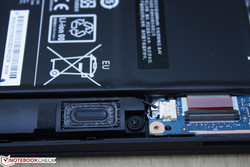
The speakers are identical to the ones on the Yoga 3 14. Thus, sound quality is lacking in bass and in range. We can notice no static at higher volume settings and volume is loud enough to be sufficient for the occasional video or music. Earphones continue to be the superior solution if available.
Battery Life
The non-removable Li-Ion battery is smaller in capacity compared to the Yoga 900 even though the Yoga 700 is a larger convertible. Runtimes are still respectable from the Yoga 700 at just over 6 hours of constant WLAN use. Lenovo promises up to 7 hours of continuous video playback, which is certainly achievable if active background applications are kept at a minimum.
Competing notebooks like the HP Pavilion 14t and Acer Aspire E5 have smaller capacity batteries and shorter runtimes overall. The large battery runtime gap between our Idle and WLAN tests means that users can squeeze out longer battery life if additional Power Profile settings are tweaked.
| Lenovo Yoga 700-14ISK 80QD 45 Wh | HP Pavilion 14t-ab000 K9E07AV 41 Wh | Acer Aspire E5-473G-59QT 37 Wh | Lenovo ThinkPad T450s-20BWS03F00 48 Wh | Lenovo Yoga 3 14 45 Wh | Dell Latitude E7450 54 Wh | |
|---|---|---|---|---|---|---|
| Autonomie de la batterie | -13% | -27% | -13% | 43% | 5% | |
| Reader / Idle (h) | 12.5 | 10.8 -14% | 9.4 -25% | 12.9 3% | 19.7 58% | 11.9 -5% |
| WiFi v1.3 (h) | 6.1 | 3.9 -36% | 4.7 -23% | 4.6 -25% | 7 15% | |
| Load (h) | 1.8 | 2 11% | 1.2 -33% | 1.5 -17% | 2.3 28% | 1.9 6% |
| WiFi (h) | 5.6 | 7.8 | 7.7 |
Points positifs
Points négatifs
Verdict
A l'instar du Yoga 3 14 à l'égard du Yoga 3 Pro l'an dernier, ce Yoga 700 ne semble être qu'une version moins travaillée du Yoga 900, destinée aux utilisateurs aux bourses un peu plus légères. Ce n'est pas forcément une mauvaise chose, dans la mesure où le coeur du concept Yoga (charnières à 360°) est intact. Le Yoga 700 est simplement plus épais, plus lourd et moins haut-de-gamme que son confrère, et donc moins agréable d'utilisation en mode tablette.
Le Yoga 700 a cependant l'avantage, du fait de son épaisseur, de pouvoir loger un GPU Nvidia dédié en son sein. Si vous avez l'intention de jouer avec votre ordinateur, nous vous recommandons l'acquisition d'une version dotée d'une de ces cartes graphiques, plutôt que d'un Yoga 900. Autrement, vous préférerez probablement vous procurer un Yoga 900, même dans une de ses configurations les moins chères, qui offrira un meilleur confort d'utilisation en mode tablette, et sera plus élégant d'un point de vue design. Si vous cherchez une alternative moins chère, les Yoga 3 14 et Yoga 3 Pro, sortis l'an dernier, restent de très bonnes machines, Lenovo ayant (presque) seulement changé sa manière de nommer les ordinateurs de cette gamme.
Le Yoga 700 est l'un des meilleurs convertibles disponibles pour moins de $1000 USD, et doté d'une carte graphique Nvidia dédiée en option. La luminosité de son écran, sa taille et son poids limitent cependant son utilisation en mode tablette à l'extérieur. Si vous cherchez une machine confortable en extérieur et aisément transportable, le Yoga 900 vous plaira certainement plus.
Cet article est la traduction d'un test complet rédigé en anglais, que vous trouverez ici.
Lenovo Yoga 700-14ISK 80QD
- 11/29/2015 v4 (old)
Allen Ngo




